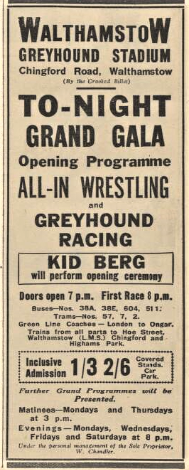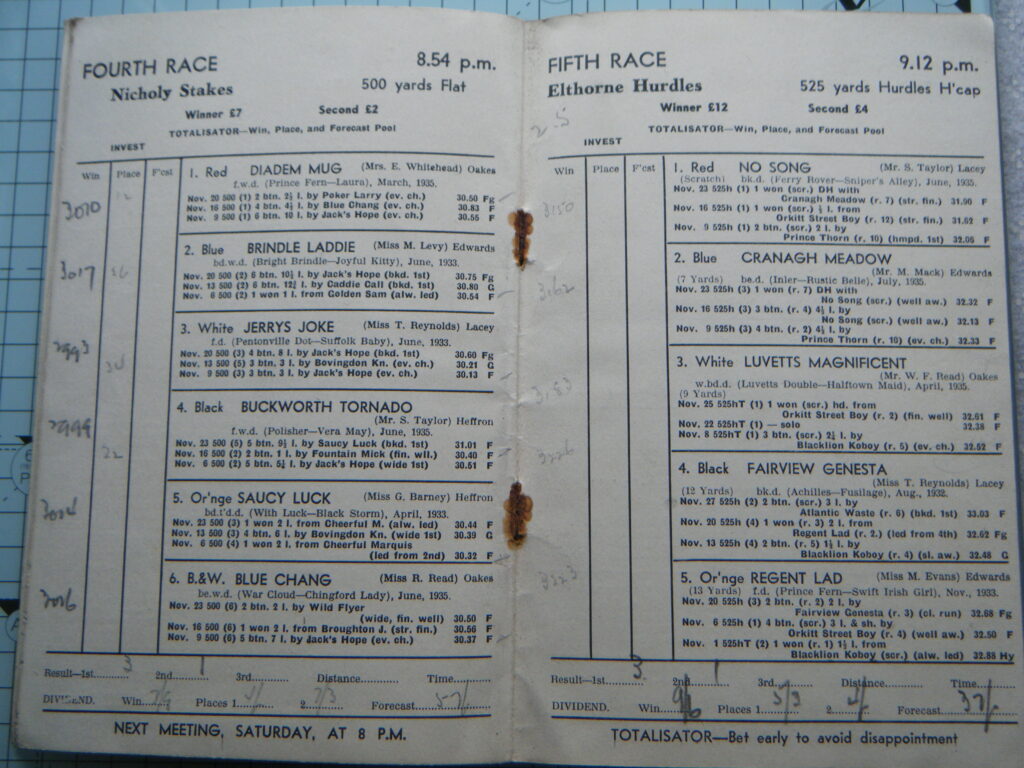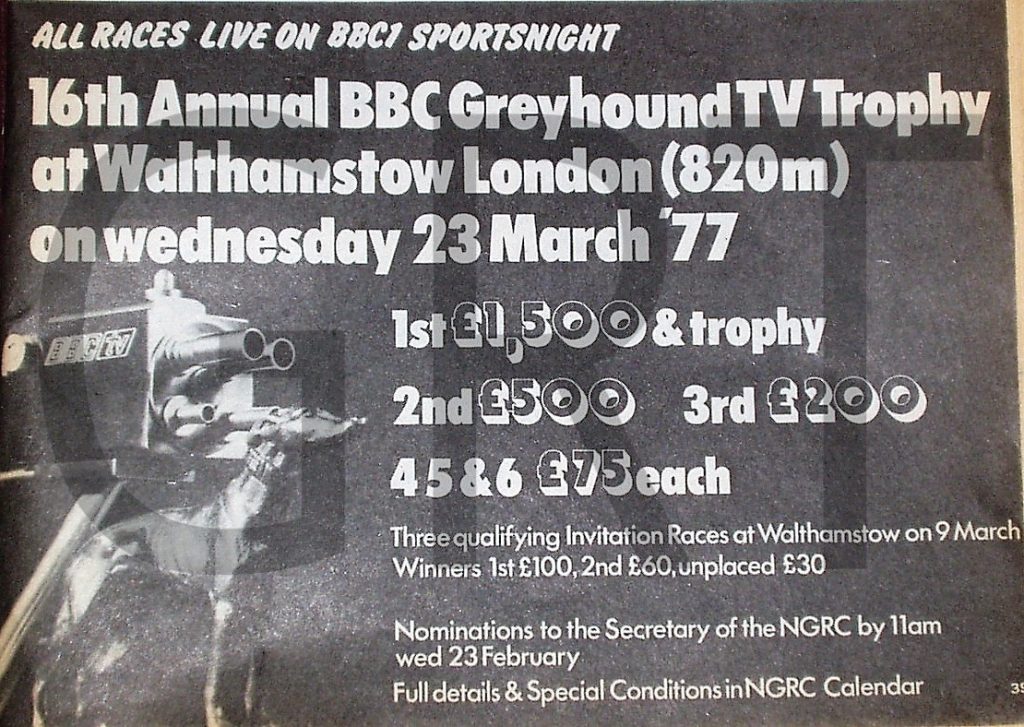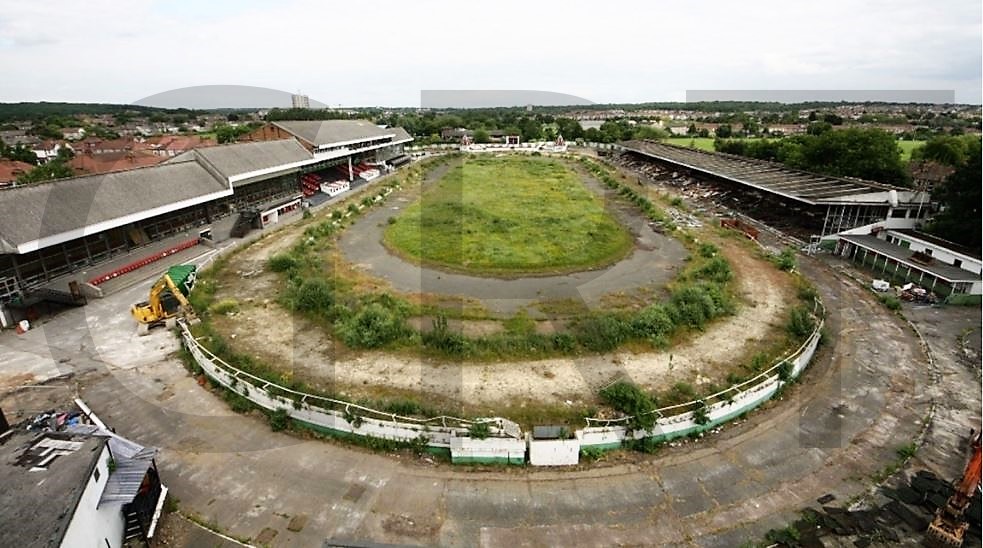Chingford Road, Walthamstow, Waltham Forest, Greater London.
POSTCODE———————————-E4 8SJ
LOCATED————————————Along the A112 Chingford Road just north of the A406 North Circular Road, about ten miles north west of London city centre.
ORIGINAL SITE—————————-Grazing land next to the River Ching, before being levelled and used as an athletics ground. This section of land became a rubbish dump after athletics had ceased.
DATE CONSTRUCTED——————–Began to develop as an amateur football ground for Walthamstow Grange Football Club during the 1920’s which became known as The Old Crooked Billet.
DATE VENUE OPENED——————-Early 1920’s for football.
Meaning other sports may have taken place prior to the arrival of Greyhound Racing.
FIRST MEETING—————————–April 15th 1931. At the Old Billet Stadium. Revamped and opened on June 19th 1933 as Walthamstow Stadium.
Greyhound Racing only.
LICENSED OR INDEPENDENT———-Independent between April 1931 and 1933. NGRC from then until closure.
All venues covered would have to be licensed with the government, licensed suggested in this section would refer to tracks operating under NGRC Rules.
INSIDE OR OUTSIDE HARE TYPE——Outside Swaffham.
Please note that the Electric Hare suggested is only a guidance, and would have been in operation for a certain amount of time at this venue. Although it is not necessarily guaranteed that it was operational all the time, as other types of lure may have been used and updated as time progressed.
DISTANCES———————————–475, 640 and 820 metres.
Please note that most racing venues distances had become varied throughout the years, the ones given above were at once point set and offers only a guidance to the track size.
CIRCUMFERENCE—————————Dont know.
Please note that alterations at most racing venues throughout its existence would see that the circumference of the track would vary, the one shown above offers only a guidance to the track size.
BIG RACE NAMES—————————The Racing Post Festival, The Arc, The Gran Prix and The Stow Marathon to name a few.
STADIUM SHARED WITH——————Stock Car Rcing 1962-1974 and Speedway on and off between 1934 and 1951.
LAST MEETING——————————-August 16th 2008.
Greyhound Racing only.
STADIUM CLOSURE DATE—————-2008
Meaning other sports may have taken place after Greyhound Racing had ceased.
STADIUM DEMOLITION——————-Began 2011.
BUILT ON SITE——————————-A cluster of new apartments on Parade Gardens now cover the majority of the site, although the huge entrance to the venue seems to have been preserved for some other use.
In some cases, structure’s that originally covered the venue after the stadium had been demolished, may have been themselves demolished too, so the one described is more likely to be the one which now presently covers the site.
EVIDENCE LEFT TODAY——————-Nothing known of.
FURTHER COMMENTS——————–None

The advert dated 05 June 1931 indicates racing on the site three times a week in its early days



























The site of the old Walthamstow Stadium lies roughly ten miles north east of the city of London, situated in the Borough of Waltham Forest, located along the side of the A112 Chingford Road. Origins of the old stadium’s site was nothing more than grazing land, that lay on the banks of the River Ching, and only began to change during the turn of the twentieth century, when the site became levelled and drained to be used as an Athletics track.
After a brief spell of sporting activities, the track was abandoned, and the site became used by the council as a rubbish dump. It was during the 1920’s that the land became levelled again, this time to be used as a football pitch, and became known as The Old Crooked Billet, with local amateur side Walthamstow Grange playing matches there. But the football club struggled financially due to poor support and folded in 1931. It was shortly after this period that an independent greyhound company took control of the site and transformed its rectangular shape of a football pitch into the more oval shape that a greyhound track required, before adding the necessary equipment in time for its first meeting of the 15th of April 1931.
However, further changes came during 1933, when a local bookmaker called Victor Chandler purchased the venue for £24,000 and renamed it “The Walthamstow Greyhound Stadium”. The new management set about by investing and upgrading not just the venue but the sport itself, by staging events under NGRC rules. New grandstands were built, each one consisting of a glass fronted restaurant, with the rest of the stadium lit up by a colourful display of lighting in various forms, all with the intention of attracting large crowds.
A special Gala meeting was staged on the 19th of June 1933 to celebrate is opening. The attractive venue began to gain respect amongst its followers and became known as the Las Vegas at the end of the Victoria Line. Other sports featured at The Stow, such as Speedway Racing, which first ventured during 1934, but surprisingly lasted for just one season only. The sport reappeared once more in 1949 again only briefly, before being abandoned after just two seasons.
Stock Car Racing also played a part in its history, featuring for the first time in 1962, and would continue for the next twelve years, before that too ceased. Walthamstow had a colourful history not only with the track lights, but also a night club known as Charlie Chans, which sprang into life in 1984 and was situated inside the colourful totalisator board.
The Stow had also featured on TV and in feature films, and also had been pictured on the pop group’s Blur’s “Park Life” album cover. Even David Beckham could boast he was once an employee there, spending numerous evenings just collecting beer glasses. The Stow maintained its 1930’s look throughout its existence, with its well-maintained grandstands and its distinctive coloured lighting.
In 1971, a new glass fronted grandstand was constructed, which would stretch the whole way along the start and finish enclosure. The 1990’s witnessed further changes for its racegoers, with a BAGS contract signed up for 1993, and then in 1994 the grass circuit that had served Walthamstow from the start was switched to sand, at a cost of £50,000. It had a crowd capacity of 5,000, even after new stadium regulations had been imposed, with big race events being staged such as The Stow Marathon, The Racing Post Festival, The Grand Prix, The Arc and The Stewards Cup, all becoming just a few to mention. Six dog races were contested over 475, 640 and 820 metres, with the hounds chasing an outside Swaffham type hare.
Sadly, the 21st century had seen the numbers of punters through the turnstiles fall drastically, along with the closure of The Charlie Chans Nightclub in November 2007, it became clear that The Stow’s future lay in the balance. Sadly in 2008, it was announced that a development consortium’s offer of 31 million pounds had been accepted by the stadium’s owner, and that the venue was about to close in the foreseeable future.
Walthamstow Greyhound Stadium staged its final meeting on the 16th of August 2008 with a greyhound called Mountjoy Diamond winning the very last race. The coloured lights of the stadium had been switched off for the very last time, it was now a period that would give the vandals and weeds an opportunity of what they are good at.
A number of attempts were made to re-open The Stow from people who remained loyal, but the chances of a return to Greyhound Racing remained remote. Part of the stadium became demolished during 2011, after its foundations became levelled ready for new housing to take its place in 2013. With this chapter now updated it is sad to say that any remnants of The Stow have all now disappeared beneath new constructions, with it a large chunk of Greyhound Racing’s history gone with it too, which will no doubt be sadly missed by so many.
Memorabilia for this track is required for this page, if you can help please contact me.

Recent Comments